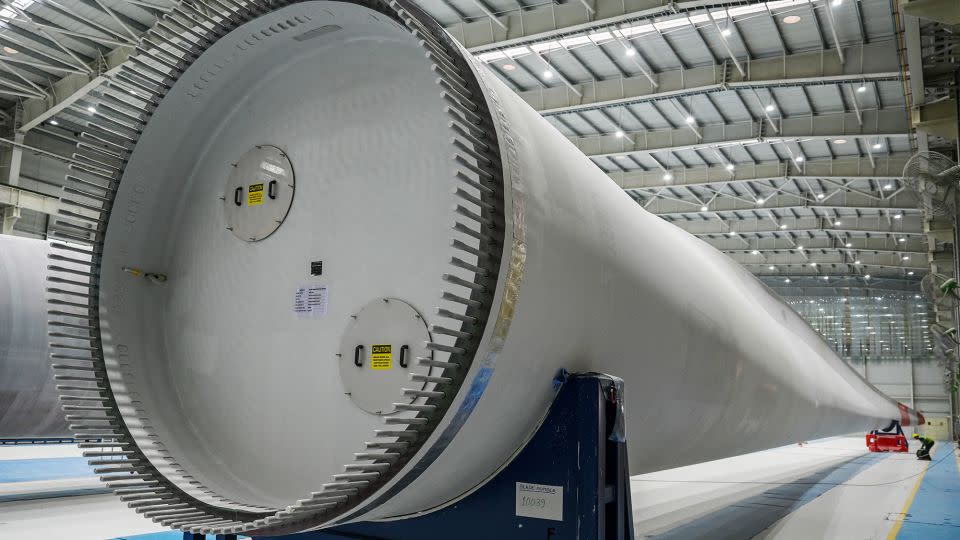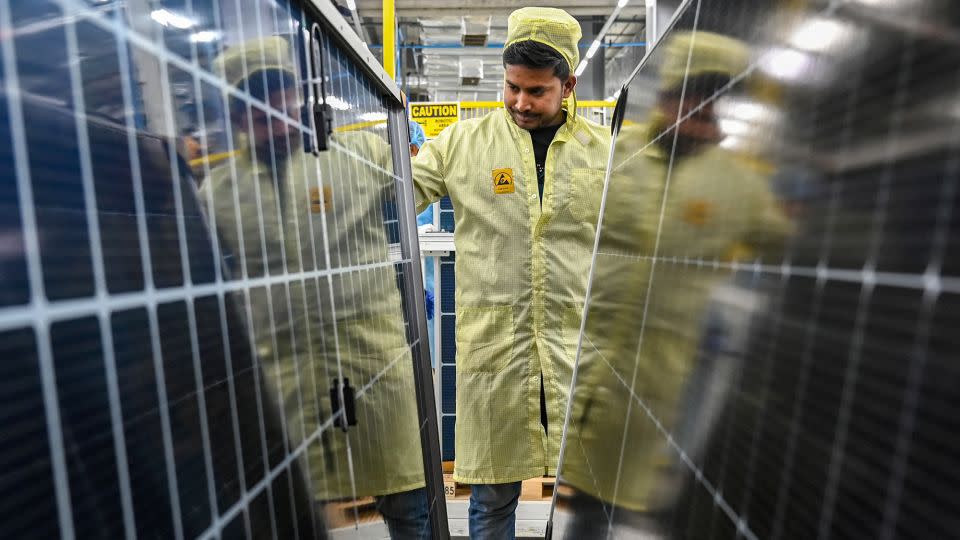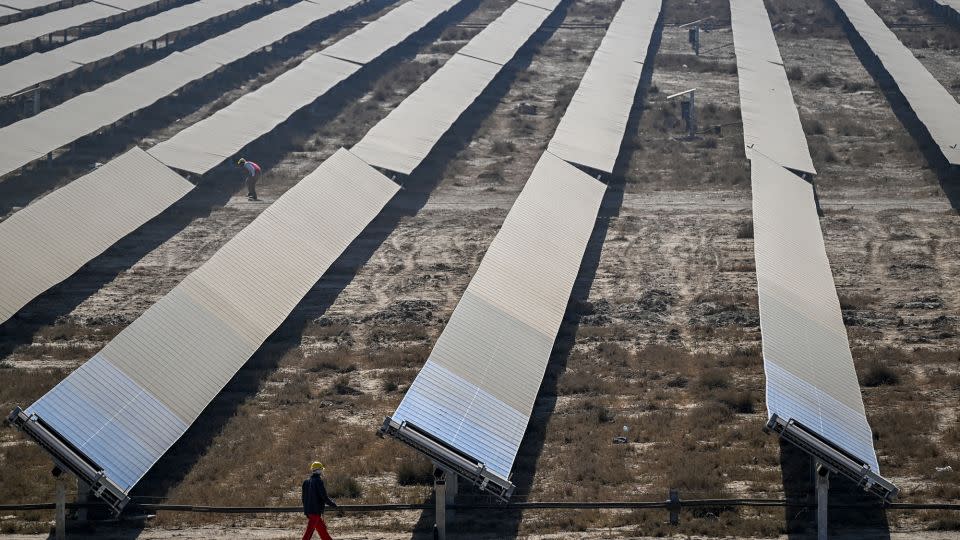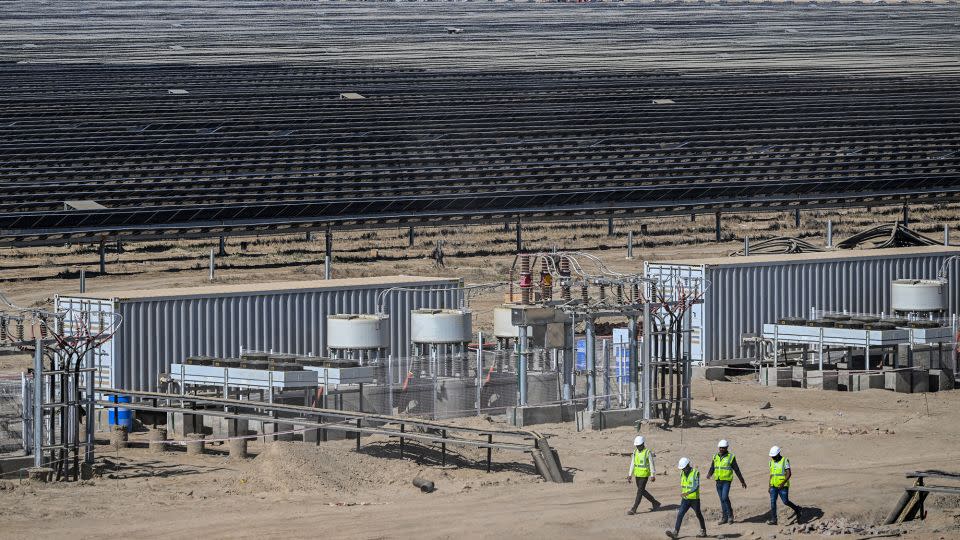Five times the size of Paris. Visible from space. The largest energy power plant in the world. Enough electricity for Switzerland.
The scale of the project, which will transform vast swaths of the barren salt flats on the edge of western India into one of the world’s most important sources of clean energy, is so overwhelming that those responsible cannot keep up.
“I don’t even do the math anymore,” Sagar Adani said in an interview with CNN last week.
Adani is the Managing Director of Adani Green Energy Limited (AGEL). He is also the nephew of Gautam Adani, Asia’s second-richest man, whose $100 billion fortune comes from the Adani Group, India’s largest coal importer and a leading miner of the dirty fuel. Founded in 1988, the conglomerate has businesses ranging from ports and thermal power plants to media and cement.
Its clean energy unit AGEL is building the sprawling solar and wind power plant in the western Indian state of Gujarat for around $20 billion. When completed in about five years, it will be the largest renewable park in the world and generate enough clean electricity to power 16 million Indian homes.
The success of the Khavda Renewable Energy Park is critical to India’s efforts to reduce pollution and achieve its climate goals while meeting the growing energy needs of the world’s most populous country and fastest-growing major economy. Coal still accounts for 70% of the electricity generated in India.

The park is just 12 miles from one of the world’s most dangerous borders, separating India and Pakistan. It will span more than 200 square miles and will be the largest power plant in the world, regardless of energy source, AGEL said.
“Such a large region, a region that is so unpolluted, there is no wildlife, no vegetation, no habitation. There is no better alternative use of this land,” Adani said.
The group’s big green plans have not been affected by the turbulent year since January 2023, when American short seller Hindenburg Research accused it of decades of fraud.
The Indian mining and media group condemned Hindenburg’s report as “baseless” and “malicious.” But that couldn’t stop the stunning collapse of the stock market, which at one point wiped more than $100 billion off the value of listed companies. Gautam Adani’s personal wealth also took a hit, plunging by more than $80 billion in the month following the report’s release.
But the tycoon has now recovered and is now investing billions in the clean energy sector.
The company plans to invest $100 billion in the energy transition over the next decade, with 70% of investments dedicated to clean energy.
A necessity for 1.4 billion people
Adani Group’s move to clean energy comes at a time when India has set some ambitious climate goals. Prime Minister Narendra Modi has promised that renewable sources such as solar and wind power will meet 50% of India’s energy needs by the end of this decade.
In 2021, Modi promised that India would achieve net-zero emissions by 2070, still a few decades later than developed economies.
The government has set a target of reaching 500 gigawatts (GW) of non-fossil fuel power generation capacity by 2030. AGEL, the country’s largest renewable energy company, aims to provide at least 9% of this, with nearly 30 GW generated in Khavda park in Gujarat alone.
Failing to transition to renewable energy is not an option, Adani said.
“India has no choice but to start doing things on a scale and scale never imagined before,” the 30-year-old said.


Because energy demand will explode in the coming years.
India is the third-largest energy-consuming country in the world, although its energy consumption and emissions per person are less than half the world average, data from the Paris-based International Energy Agency (IEA) shows.
That could change quickly. Thanks to rising incomes, energy demand has doubled since 2000, with 80% of this still being met by coal, oil and solid biomass. Over the next three decades, the fast-growing economy will see the largest increase in energy demand of any country in the world, the IEA said.
“If India does what China did, if India does what Europe did, if India does what the US did, then we all face a very, very bleak climate future,” Adani said, citing the historic one Use of fossil fuels these countries developed.
His dire predictions are not dramatic. Analysts say India is well-positioned to grow at an annual rate of at least 6% in the coming years and could become the world’s third-largest economy this decade.
As development and modernization occur, the urban population will increase sharply, leading to a massive increase in the construction of apartments, offices, shops and other buildings. Analysts say India will increase its urban population by the equivalent of one London every year for the next 30 years.
Electricity demand is expected to skyrocket in the coming years due to factors ranging from improved living standards to climate change. The latter has led to deadly heatwaves across India and as a result, air conditioning ownership is set to rise sharply in the coming years.
By 2050, India’s total electricity demand from residential air conditioning is expected to exceed the total energy consumption across Africa today, the IEA said.
India cannot rely on fossil fuels to meet its growing needs without having catastrophic consequences for efforts to address the climate crisis.
“If you imagine adding 800 GW of coal-fired thermal capacity, then that will wipe out all other sustainable energy initiatives around the world in terms of carbon emissions alone,” Adani said.


On both sides of the street
The company’s green plans are impressive, but climate experts are critical of the continued massive investments in fossil fuels.
“[Gautam] Adani continues to walk both sides of the street,” said Tim Buckley, director of Sydney-based think tank Climate Energy Finance.
In addition to being one of the largest developers and operators of coal mines in India, Adani Group also runs the controversial Carmichael Coal Mine in Australia, which has faced strong opposition from climate activists who say it is a “death sentence” for the Great Barrier coal mine Reef.
“Instead of pouring billions into new fossil fuel projects, India would be much better served if Adani put 100% of its efforts and resources into developing low-cost, zero-emissions technologies,” Buckley added.
That is currently not an option, said Adani.


More than 600 million people in India will “move into middle and upper income levels in the next decade, decade and a half,” he said. “They must not be deprived of their basic energy needs. ”
Everyone would be happy if we could “cover 100% of this from sustainable energy sources…”[but]… practically speaking, that’s not an option at the moment,” he added.
He also said activists in developed countries that have historically emitted more greenhouse gases are often unable to understand the daunting challenge India faces in growing its economy and its clean energy industry simultaneously.
“I think it is also very important to respect the fact that each country has its own right to ensure that the people of its own country are well served from an energy perspective,” Adani said.
“So is India making a bit of coal? Yes, of course India is. But is India building massively on renewable energies? Yes, no question,” he added
For more CNN news and newsletters, create an account at CNN.com
